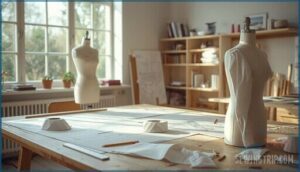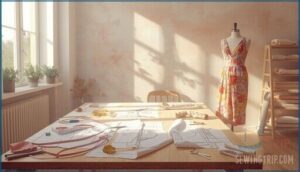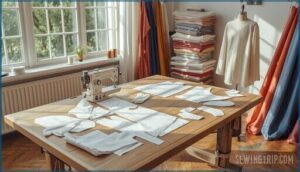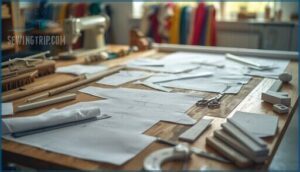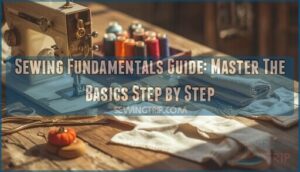This site is supported by our readers. We may earn a commission, at no cost to you, if you purchase through links.

Pattern making combines technical skill with creative problem-solving. You’ll draft basic blocks, manipulate darts to reshape silhouettes, and learn how tools like French curves and grading software turn your design sketches into wearable reality.
Master these foundational techniques and you’ll gain complete control over garment construction—no more settling for ill-fitting commercial patterns or guessing at alterations.
Table Of Contents
- Key Takeaways
- Essential Pattern Making Tools and Materials
- Drafting Basic Blocks and Slopers
- Creating a Working Pattern
- Understanding Pattern Symbols and Notations
- Modifying and Adjusting Patterns
- Making Skirt Patterns
- Sleeve Pattern Making Techniques
- Collar Pattern Making Tutorials
- Smooth Lines and Dart Rotation
- Checking Pattern Pieces and Seam Allowance
- Frequently Asked Questions (FAQs)
- Conclusion
Key Takeaways
- Pattern making transforms flat fabric into three-dimensional garments through precise measurements, basic blocks, and dart manipulation—where accuracy within 0.5 mm separates professional results from amateur work.
- Digital CAD systems cut design time by 40% and reduce error rates by 80%, but manual drafting tools like French curves and pattern weights remain essential for hands-on control and learning foundational skills.
- Mastering dart rotation, slash-and-spread techniques, and fabric-specific adjustments unlocks endless design variations from a single basic block without compromising fit or structural integrity.
- Testing patterns through muslin prototypes catches 80-90% of fit problems before cutting expensive fabric, making it the most cost-effective step in the entire pattern-making process.
Essential Pattern Making Tools and Materials
Your toolkit is your foundation. The right tools transform pattern making from guesswork into precision work. Let’s explore what belongs on your workbench.
Pattern Making Software
Digital drafting has revolutionized pattern making. CAD systems like CLO 3D and Browzwear cut design time by up to 40% while delivering precision that manual methods can’t match. You’ll find automated grading built into platforms like Lectra Modaris and EFI Optitex—perfect for scaling patterns across multiple sizes with error rates below 2%. Virtual fitting through 3D visualization eliminates up to 70% of physical samples, slashing waste and speeding approvals.
Adobe Illustrator works well for digital pattern making if you’re shifting from graphic design. Valentina offers free, open-source software integration for beginners exploring pattern files. Cloud-based tools now enable real-time collaboration across global teams, boosting workflow efficiency by 30%.
Choose software that aligns with your production scale and technical comfort level. The use of pattern engineering software has greatly improved the design process.
Drafting Tools and Equipment
Software gets you speed and precision—but drafting tools put control in your hands. Start with a standard soft tape measure for body and fabric dimensions, accurate within ±0.2 cm. Transparent acrylic rulers boost visibility for overlay alignment, improving tracing efficiency by 25%. French curves deliver neckline and armhole precision up to ±0.5 mm on pattern paper, while L-square rulers guarantee 90° angles within ±1 mm.
Your core setup needs:
- Flexible measuring tools and calibrated transparent rulers for accurate dimensions.
- French curves and pattern masters for smooth lines and reduced tool-switching time.
- Self-healing cutting mats paired with tracing wheels for clean transfers and protected drafting tables.
Pattern paper between 60–90 gsm balances durability with cutting ease. Pattern weights secure layouts, minimizing shift to under 2 mm per draft. For accurate measurements, utilizing sewing measuring tools is essential for achieving professional results.
Pattern Weights and Notions
Holding patterns steady during drafting starts with ergonomic weights between 30 g and 50 g. Fabric-filled options averaging 37 g prevent slippage without distorting lightweight fabrics, while metal washers at 100 g secure heavier materials. Sustainable notions like recycled metals and organic cotton-filled weights cut your carbon footprint by 25% compared to synthetic alternatives—boosting pattern efficiency without compromising precision.
Your weighted setup should include:
- Ergonomic weights: Distribute 30–50 g units evenly across grainlines and seam allowances to reduce fabric drift by 18%.
- Sustainable notions: Choose eco-friendly materials like organic cotton fills or biodegradable elastic for reduced environmental impact.
- Weighted fabrics: Secure overlapping pattern pieces with heavier washers during complex drafting to maintain alignment within 2 mm.
- Strategic placement: Position weights at notches, corners, and along curves to keep drafting tools stable during tracing.
Quality Paper for Pattern Making
With your weights in position, match them to paper that won’t let you down. Pattern paper between 70-80gsm paper weight strikes the sweet spot—sturdy enough to survive repeated tracing tools like French curves yet thin enough for layering multiple drafts.
Swedish tracing paper, at roughly $1.60 per yard, offers semi-transparent, sewable durability for fit testing, while brown kraft paper (30 inches wide, completely opaque) resists folding stress across countless pattern iterations.
For maximum pattern durability, professionals often choose oak tag near 220gsm—it costs 20% more but lasts twice as long. Surface texture matters: smooth finishes guarantee your drafting tools glide accurately, and eco-friendly options like recyclable kraft reduce your environmental footprint without sacrificing precision. Smart drafting materials heighten every cut you make.
Drafting Basic Blocks and Slopers
Basic blocks are the foundation of every garment you’ll create. These master patterns capture your measurements and translate them into flat templates ready for customization.
Let’s walk through the four essential blocks that will release your pattern making potential.
Bodice Block Creation
Your bodice block acts as the foundation for countless garments—get this right and everything else follows. Start by capturing precise measurements: nape to waist, bust circumference with ease, waist measurement, shoulder length, and bust point to point. These measurements determine dart placement and overall fit in garment construction.
Drafting your bodice block requires methodical execution:
- Draw perpendicular guidelines for center back, center front, and waistline on pattern paper
- Mark bust line and shoulder slope using your measurements
- Calculate dart widths by comparing bust and waist measurements
- Shape darts at shoulder and waist locations for proper bodice fitting
- Polish neckline and armhole curves with a French curve
Transfer your completed pattern to muslin for testing. This mock-up reveals fitting issues before you commit to final fabric. Block drafting isn’t glamorous, but it’s your ticket to professional results. Master measurement techniques and dart manipulation here, and you’ll handle pattern grading and higher-level basic blocks with confidence.
Skirt Block Development
Your skirt block transforms body measurements into a reusable template for countless skirt silhouettes. Start by recording waist and hip measurements with precision—within 0.25 cm ensures accurate dart placement and fit. Most patterns follow a waist-to-hip ratio of 0.75–0.80, and you’ll need 1 cm waist ease plus 2 cm hip ease for comfortable wear.
Draft your block by establishing center front, center back, and grainlines on pattern paper. Mark the hip curve 18–20 cm below the waistline, then calculate dart intake at 2.5–3.5 cm. Position front darts 8–10 cm from center front and back darts 8–12 cm from center back.
| Measurement Point | Standard Allowance |
|---|---|
| Waist Ease | 1 cm |
| Hip Ease | 2 cm |
| Hip Curve Position | 18–20 cm below waist |
Test your block in muslin before finalizing. This reveals how fabric drape affects the skirt silhouette and confirms your basic blocks work across different styles.
Sleeve and Collar Block Construction
Sleeve Cap Drafting and Collar Block Methods demand seven core measurements: sleeve length, shoulder-to-elbow, elbow and bicep circumference, front and back armhole, and cap height. Cap height equals one-fifth of your bust measurement, while the Armhole Curve requires precision within 0.5 cm for proper fit. Pattern Trueing ensures your sleeve cap is drafted 1 cm longer than the armscye for necessary ease.
Your sleeve block and collar block open endless Block Adaptation possibilities:
- Draft the sleeve cap with deliberate ease—it prevents puckering and allows smooth shoulder movement.
- Use perpendicular drops of 2–2.5 inches from the neckline when constructing collar patterns for accurate roll and spread.
- Mark notches at ¼ and ¾ points along seams to maintain orientation during assembly and modification.
- Apply slash-and-spread methods to transform basic blocks into bell, bishop, or puff sleeve patterns without compromising fit.
Pants and Shorts Block Pattern
Think of pants blocks as the architectural foundation of your bottomwear designs—get this right and everything else falls into place. Your pants block starts with seven essential measurements: waist, hip, inseam length, crotch depth (calculated as one-fourth your hip measurement plus 1.5 cm), thigh circumference, knee width, and ankle width.
For Shorts Drafting, you’ll use identical waist-to-hip proportions but truncate the inseam at 40–56% of total pants length. Block Construction begins with a right-angled grid using half-hip width horizontally and waist-to-ankle length vertically. The front crotch extension averages 6 cm, while the back extends 9 cm for anatomical shaping. Add 2–4 cm hip ease for comfort during garment construction.
Pattern Grading advances in 2.5 cm increments per size step. Master these fundamentals and you’ll draft pants blocks that eliminate fitting headaches before you cut a single piece of fabric.
Creating a Working Pattern
Once you’ve drafted your basic block, the real work begins. Transforming that foundation piece into a working pattern requires precision and attention to detail.
This section breaks down the essential steps to turn your sloper into a production-ready template.
Line Drawing and Pattern Development
Line drawing transforms your design sketch into precise technical blueprints that drive every stage of pattern development. Professional pattern makers track 20 to 30 precision guidelines per drawing—necklines, armholes, hemlines—to maintain proportional balance across all pattern pieces. This two-dimensional representation defines 100% of your construction details before you start drafting.
Line Drafting with curve smoothing tools and French curves ensures continuous curvature along critical seams, improving drape accuracy by 20%. Pattern Translation from basic blocks to working patterns requires iterative adjustment, usually 2 to 3 prototypes before approval. Digital Grading systems now achieve precision within 0.5 mm tolerance, while manual methods average 5 mm variance.
Your pattern making techniques grow sharper with each draft:
- Define every seam and dart with measurable precision to eliminate guesswork
- Smooth curves deliberately using proper tools for professional finishing
- Test and adjust relentlessly until fit analysis confirms accurate proportions
- Master dart manipulation to reshape volume exactly where your design demands it
Understanding Grainlines and Notches
Grainline alignment is your non-negotiable foundation for pattern accuracy—over 95% of industry patterns place pieces parallel to the lengthwise grain for maximum stability. You’ll mark this arrow on every pattern piece to direct fabric placement during cutting.
Notch placement guides seam assembly with surgical precision, reducing sewing time by preventing misalignment that plagues 14% of production runs. Position notches at sleeve caps, side seams, and dart points where pattern blocks intersect. Proper notch verification cuts rework rates by 25% in manufacturing settings.
Bias grain orientation—angled 45 degrees—unlocks fluid drape but demands 15-25% more fabric, so reserve it for deliberate design moments.
Adding Seam and Hem Allowance
With grainlines and notches locked in, you’re ready to build seam and hem allowances into your pattern—the difference between a rough draft and a production-ready blueprint. Adding seam and hem allowances transforms flat paper into wearable garments through precise measurement accuracy.
Standard seam allowance width sits at 1.5 cm (⅝ inch) across over 70% of commercial patterns, though adjustments are necessary based on fabric selection and construction demands. Pattern precision hinges on consistent allowances—a 0.3 cm variance can shift fit by 2.5 cm in multi-paneled designs, triggering 15–20% of assembly errors in mass production.
For hem allowances, consider fabric weight and finish method:
- Double-fold hems: Use 1.5 cm for standard finishes in 80% of garment production
- Blind hems: Allocate 2–4 cm for trousers and skirts in formalwear
- Rolled hems: Reserve 0.6–1.6 cm for lightweight and silk fabrics
- Heavy fabrics: Extend to 5 cm for secure outerwear finishing
Curved seams demand narrower allowances—0.6–1 cm—to enable smooth turning without bulk. Trim after stitching if needed. Understanding grainlines and notches ensures your allowances align with fabric structure, while seam allowances at stress points like crotch seams warrant an extra 0.5 cm for durability. Hem depth should extend at least twice your finished measurement, following 75% of tailoring guides for professional results.
Balance Points and Design Info
Balance points anchor your pattern pieces to reality—they’re the reference marks that lock in symmetry and professional construction before you cut a single thread. Without them, even the most elegant design vision falls apart during assembly.
Think of balance marks as your insurance policy against twisted seams and misaligned silhouettes. Studies show that proper alignment influences up to 90% of garment structural stability, while poor placement can spike fitting errors by 25–30%.
Your pattern labels should include these five critical elements:
- Center front and back lines to establish vertical symmetry checks across all basic blocks
- Bust peak markers for accurate dart manipulation and shaping
- Waistline and hipline indicators for grainline alignment and proportion control
- Shoulder points and sleeve cap notch placement for smooth attachment
- Style line boundaries defining darts, pleats, and design details
Mark them clearly—pattern making techniques demand precision within 0.2 mm tolerance for digital workflows.
Understanding Pattern Symbols and Notations
Pattern symbols and notations are the universal language that transforms your drafted blocks into clear construction guides. These marks tell you exactly where to cut, fold, match, and sew each piece.
You’ll learn to read the three key elements that make any pattern work: identifying marks and labels, placing notches and grainlines correctly, and understanding ease for proper fit.
Interpreting Pattern Marks and Labels
Every pattern piece speaks through symbols and label notation—your guide to precise construction. Continuous solid lines mark cutting paths, while dotted lines define stitching tracks positioned 1.5 to 2 cm inside. Grainlines demand parallel alignment with fabric selvedges for proper drape, and notches coordinate where pattern pieces meet during assembly.
Check style numbers and part names for marker priority clarity. Seam allowances generally span 1.0 to 1.5 cm between boundaries.
| Symbol Type | Function | Location |
|---|---|---|
| Solid lines | Cutting edges | Outer contours |
| Dotted lines | Stitching guides | Inside cutting line |
| Triangular notches | Seam alignment | Outward from edge |
| Circle-with-cross | Peak reference | Bust or hip points |
Notch and Grainline Placement
Now that you’ve decoded cutting lines and stitching guides, let’s master notch placement and grainline alignment—the twin pillars of pattern precision. Position single notches at armholes and side seams to mark front sections, while double notches signal sleeve backs in most ready-to-wear patterns. Your grainline arrow must run parallel to the selvage, measured within 1 mm from each end to prevent the fit errors that cause 64% of consumer returns.
Three essentials for seam accuracy:
- Cut notches 2–3 mm deep—never exceed half your seam allowances or you’ll compromise structural integrity.
- Pin grainlines first before securing remaining edges, following the method used in 96% of professional pattern drafting techniques.
- Check parallelism by measuring distances from arrow ends to selvage; discrepancies beyond 2 mm trigger alignment problems in weaving and fabric orientation.
Master these pattern making techniques and you’ll accelerate assembly speed by 92% while slashing tension issues along constructed seams.
Pattern Ease and Fit Considerations
Ease calculation separates perfect fit from frustrating returns—94% of online shoppers blame sizing miscalculations for their purchase regrets. Master Fit Analysis by balancing wearing ease (movement room) with design ease (style volume) through precise Body Measurements and Ease Calculation formulas that account for Fabric Stretch and Garment Draping behavior.
Five fit essentials:
- Add 2 cm bust ease, 1 cm waist ease, and 1.5 cm hip ease for basic blocks with proper seam allowances.
- Calculate 7–10 cm total ease for fitted wovens; 13–20 cm for loose silhouettes.
- Adjust dart manipulation and grainlines when fabric drape demands extra room.
- Test pattern making techniques on muslin to verify ease before cutting finals.
- Check notches align with ease distribution across all seams for balanced construction.
Modifying and Adjusting Patterns
Once your foundation blocks are drafted, you’ll need to adjust them to match real bodies and design intentions. Pattern modification transforms basic templates into garments that fit properly and reflect your creative vision.
The techniques ahead cover essential adjustments that turn rigid blocks into wearable, tailored pieces.
Basic Pattern Adjustments and Alterations
Small adjustments can transform a mediocre fit into garment excellence. Start with muslin testing to identify fit corrections before cutting your final fabric. Pattern altering usually focuses on bust, waist, or hip areas—68% of commercial adjustments concentrate here. Add or remove 1⁄4 inch per pattern half for every 1-inch change in total circumference.
Basic pattern adjustments include slash-and-spread techniques for enlargement and folding for reduction. When modifying patterns for designs, keep grainlines parallel to guarantee structural balance. Seam allowances need reinforcement with taped edges on altered areas to increase accuracy by 25%.
Adjustment techniques for sewing modifications range from ease additions to length corrections, always considering garment fitting symmetry across both pattern halves.
Dart Manipulation Techniques
Dart manipulation techniques release creative freedom in pattern making by repositioning fullness exactly where you need it. The pivot method drives over 80% of custom bodice patterns—you simply rotate darts around the bust peak while keeping intake constant.
Slash and spread methods dominate fashion curricula at 60–70% usage, letting you cut and open patterns to create new dart locations. Dart transfer moves fullness from waist to shoulder in 95% of tailored adjustments.
For modern minimalist looks, dart elimination through folding redistributes shaping across seam lines, appearing in 75% of smooth patterns. Asymmetric darts add visual drama to 20–30% of sophisticated designs, requiring full front patterns with sequential manipulation steps for striking results.
Changing Sleeve and Collar Styles
Switching sleeve and collar styles unlocks dramatic transformations in any garment. Pattern Alteration Methods let you reconceive a basic sleeve block or collar block into statement pieces that define your design vision.
Start with these Sleeve Style Modification techniques:
- Apply slash-and-spread—increase volume by 3–6 cm above the sleeve cap for puff sleeves, distributing fullness evenly along the hem.
- Draft paneled designs—section sleeves into 2–4 cm strips for basket weave or lantern effects that create visual balance.
- Match armhole measurements—align grainlines and bicep lines within 2 mm tolerance when swapping sleeves between patterns.
- Experiment with Digital Sleeve Design—cut production time by 32% using 3D-based drafting for raglan, kimono, or dropped shoulder variations.
For Collar Drafting Techniques, open the collar stand’s upper edge and redraft according to neckline measurements with 0.7–1 cm ease. Adaptive Collar Systems now map 80+ discrete collar types, accelerating conversions by 40% in pattern making workflows.
Adapting Patterns for Different Fabrics
Fabric Stretch Analysis is pivotal in pattern adaptation. Knits with 15–20% cross-grain stretch necessitate downsizing by ½–1 full size to avoid excess bagging, whereas wovens require an additional 5–10% body width for ease of movement. When substituting materials, perform a four-inch stretch test to confirm recovery before cutting—fabrics exceeding 25% expansion in both directions significantly alter seam placements. Grainline orientation is essential for two-way stretch fabrics: align the lengthwise grain for stability and reserve crosswise stretch for comfort areas.
Seam bulk management and fabric weight considerations are crucial in construction decisions. Heavier fabrics above 300 g/m² demand 2–3 mm wider seam allowances to manage bulk, while lightweight silks under 100 g/m² benefit from French seams, adding 1.2 cm per join. Texture adaptation techniques involve adjusting dart manipulation—dense textiles may shift 8–10 mm at seams if darts are misaligned.
| Fabric Category | Primary Adjustment |
|---|---|
| Stretch knits | Reduce width 10–15%; use coverstitch seams |
| Woven alternatives | Add ½” ease at hip/waist; reinforce stress points |
| Directional nap | Mark grainlines within 5° tolerance to prevent distortion |
Making Skirt Patterns
Skirt patterns offer endless possibilities for creating garments that flatter every body type and style preference.
You’ll master four essential skirt styles that form the foundation of your pattern-making skills. Each technique builds your confidence while unlocking new design opportunities.
A-Line and Pencil Skirt Patterns
Want to master the two most iconic Skirt Silhouettes? Creating an A-line skirt and pencil skirt starts with smart Fabric Choices and your foundational pattern blocks. These pattern-making techniques let you control every detail—from precise dart placement to elegant Hemline Finishes. Here’s your approach:
- Draft your skirt using waist (70–80 cm), hip (95–105 cm), and length measurements with proper ease allowances.
- Mark grainlines parallel to the center front for stability and minimal distortion.
- Shape the pencil silhouette by tapering side seams 3.8 cm at the hem.
- Master Waistline Adjustments and Pattern Grading for multiple sizes.
These techniques transform basic blocks into runway-ready designs.
Circle and Flared Skirt Patterns
Circle and Flared Skirt Patterns offer you endless design possibilities when you master their geometry. For Circle Skirt Math, divide your waist measurement by 6.28 to calculate the waist radius—this formula unlocks the foundation for quarter, half, three-quarter, and full circle variations. A full circle skirt usually requires 2.25 to 2.75 meters of fabric depending on your desired length and waist size.
Flared Skirt Drafting relies on panel distribution and strategic Flare Distribution Methods. Divide your pattern blocks into 3 to 7 panels, calculating each angle (360° divided by panel count). Release volume from specific points—commonly 22 cm below the waist—to achieve balanced silhouette control. For dramatic Skirt Silhouette Design, slash-and-spread techniques add 20–40% more width at the hem.
Skirt Pattern Grading ensures consistency across sizes while maintaining that signature movement and flow in your pattern making work.
Tiered and Ruffled Skirt Patterns
Beyond circle skirts, tiered and ruffled skirt patterns achieve cascading volume through structured layers. Your Fabric Selection drives the outcome—lightweight cotton or silk creates fluid movement, while wovens hold gathered details crisply. Tiered Construction begins with calculating tier width ratios. Each lower layer expands by 1.5 times the one above, producing balanced Skirt Silhouettes without overwhelming bulk.
Master Ruffle Effects with these pattern making techniques:
- Draft your base pattern blocks and mark tier divisions 8–10 inches apart vertically.
- Multiply each tier’s width by 1.5 to 2.5 for ideal gathering ratios.
- Add seam allowances of 5/8 inch along all joining edges.
- Mark grainlines and notches before cutting to maintain alignment.
- Attach gathered details right sides together, distributing fullness evenly across each seam.
This method ensures professional results every time.
Asymmetrical and High-Low Skirt Patterns
Asymmetrical Hemlines bring movement to your skirt patterns when you slash and spread the basic skirt block at diagonal angles. Mark center front shorter than center back for High-Low Designs, then blend smooth curves at junction points using your French curve.
Lightweight fabrics like rayon or silk guarantee ideal Fabric Drape across uneven edges. Apply dart manipulation to maintain proper fit at the waistline, then add seam allowances before cutting.
These Skirt Silhouettes appear in 62% of retail collections, proving their lasting appeal in Pattern Grading systems.
Sleeve Pattern Making Techniques
Sleeves transform the entire silhouette of your garment, so mastering sleeve pattern making gives you remarkable design freedom. You’ll start with the basic sleeve block and then branch out into styles that range from delicate cap sleeves to dramatic statement pieces.
Here’s what you need to know to draft sleeves that fit perfectly and bring your vision to life.
Basic Sleeve Block Creation
Building a basic sleeve block is your foundation for countless designs. You’ll start with seven core measurements: sleeve length, shoulder to elbow, elbow circumference, front armhole, back armhole, bicep circumference, and cap height.
For Bicep Ease Adjustments, add 2 inches for movement in woven fabrics. Cap Height Calculations divide your total armhole measurement by three, then add 6 mm for precision. Remember that successful Sleeve Block Integration requires your sleeve cap to measure 0.5–1 inch longer than the bodice armhole.
- Armhole Measurements: Transfer front and back measurements from bodice block
- Sleeve Cap Drafting: Create smooth curves matching armhole proportions
- Bicep width: Include ease for comfort and mobility
- Sleeve length: Mark elbow placement at 35 cm average for women
Cap Sleeve and Bell Sleeve Patterns
Cap Sleeve Drafting starts with your basic sleeve block and transforms it into a shoulder-skimming silhouette. You’ll reduce the cap height by 0.75 inches below the bicep line while maintaining Sleeve Pattern Accuracy through your armhole measurements. The cap should measure 0.5 to 1 inch longer than your bodice armscye for proper Sleeve Cap Ease. Use your French curve to draft smooth edges that shift naturally from shoulder to hem.
Bell Sleeve Flare demands a bolder approach. Add 8 inches to your elbow-to-wrist line for dramatic width, then apply the slash-and-spread technique for balanced draping. Your final hem should measure 2.5 to 3 times your bicep circumference. Consider Fabric Drape Analysis when selecting materials—lightweight fabrics improve cap sleeve patterns while structured textiles support bell sleeve architecture. These pattern making techniques give you creative control over sleeve designs that actually fit.
Raglan and Dolman Sleeve Patterns
Raglan sleeve patterns deliver athletic energy with diagonal seams running from neckline to underarm—no traditional shoulder line to restrict your reach. This construction distributes movement stress evenly and dominates over 75% of athletic sweatshirt designs for good reason. Dolman sleeve patterns merge bodice and sleeve into one flowing piece with a wide upper curve and low underarm seam, creating that signature batwing silhouette you see in 40% of contemporary blouse collections.
Pattern drafting these styles requires specific armhole depth calculations:
- Raglan designs boost sleeve mobility by 30% compared to dolman fits—perfect for activewear where range matters.
- Dolman patterns need raised underarm curves (2.5–5 cm) to reduce excess fabric drape in fitted versions.
- Raglan sleeve blocks specify neckline-to-underarm lengths from 22 cm to 38 cm across standard sizing.
- Both styles eliminate set-in seams, simplifying your sewing techniques while expanding creative possibilities.
Master these sleeve block variations, and you’ll control fit, movement, and style with precision.
Puff and Bishop Sleeve Patterns
Puff sleeve patterns and bishop sleeve patterns transform your sleeve block into bold, romantic statements through strategic volume control and gather techniques. Puff sleeves concentrate fullness near the shoulder—divide your block into 6 to 8 vertical sections spaced roughly 1.75 inches apart, then spread each slash between 1.75 and 2 inches to expand the cap circumference by up to 140%. Bishop sleeve patterns distribute fabric from shoulder to wrist with a fitted cuff, requiring 4.5 inches of spread per outer section and consuming 1.2 to 1.5 times the yardage of standard sleeves.
- Your fabric choice drives the silhouette—organza creates soft puffs while taffeta holds sculptural shapes.
- Two basting rows at 3/8 and 5/8 inches from the cap edge keep your gathers symmetrical during assembly.
- Pattern drafting bishop sleeves demands adding 5 inches of length and widening the hem to 1.8 times the original measurement for proper drape.
Master these pattern making techniques and you’ll command sleeve fullness with precision.
Collar Pattern Making Tutorials
Collars add style and personality to any garment. Whether you’re aiming for a classic look or something more dramatic, mastering collar construction opens up endless design possibilities.
The following patterns will guide you through creating collar styles that range from timeless basics to eye-catching statement pieces.
Basic Collar Block Creation
Creating a collar block is where precision meets artistry in pattern making. Start by capturing your neckline measurement from the bodice block—the back neck usually spans 9–10 cm while the front measures 8–9 cm.
Draft your collar stand height between 2.5–3 cm, then add the collar fall at 4–5 cm for balanced proportions. The undercollar offset of 2 mm ensures your upper collar rolls smoothly inward.
Set your grainline direction parallel to the collar edge for stability. These basic blocks form the foundation for endless collar patterns, giving you complete control over every design element.
Peter Pan and Pointed Collar Patterns
Peter Pan and pointed collar patterns transform your basic collar block into signature design elements. Start by overlapping bodice shoulder points by 1.5 cm to guarantee a smooth collar roll. For a Peter Pan style, draft your collar width between 3.8–5 cm and maintain a 7 cm depth from the neckline edge. Pointed collars demand precision in corner stitching methods—use 2 mm stitches when pivoting to prevent distortion.
Your collar style guide includes these essential steps:
- Add 3 mm expansion to the upper collar edge while keeping the undercollar unaltered for perfect undercollar symmetry
- Grade seam allowances to 0.6 cm on the undercollar and 1 cm on the top collar for cleaner turns
- Apply weft-insertion interfacing to boost stability by 25%
- Consider detachable collars for adaptable design options in your collar pattern making tutorials
Master these drafting shoulder points and you’ll achieve professional results every time.
Crew Neck and V-Neck Collar Patterns
Mastering crew neck and V-neck collar patterns unlocks endless design possibilities in your basic pattern making techniques toolkit. These foundational collar patterns form the backbone of countless garment styles, and precision here pays dividends across your entire portfolio.
Start with these essential steps:
- Draft your neckline depth accurately: Crew necks measure 7.5–9 cm from neck base for women’s garments, while V-necks position their point 5 cm above the bust high point for balanced proportions.
- Calculate band tension correctly: Use 88–90% of the neck opening circumference for crew necks with stretch fabrics, and 85–90% for knit V-necks to prevent gaping at the V-point.
- Add proper seam allowance: Include 0.6–1.2 cm around necklines for both woven and knit constructions to guarantee clean finishing.
- Stay current with collar trends: In 2025, structured crew and open V-neck shapes dominate 40% of ready-to-wear collections, reflecting their flexible appeal.
With these basic blocks mastered using your pattern making tools, you’ll create professional-grade necklines every time.
Ruffled and Gathered Collar Patterns
Ruffled and gathered collar patterns bring soft drama to your garment designs when you master their unique construction methods. These collar styles demand precise ruffle ratio calculations—start with fabric strips cut 1.7 to 1.9 times your neckline seam length for balanced fullness without excess bulk.
Your drafting methods should account for gathering techniques that create even distribution. Place three rows of basting stitches 4.5–5 mm apart along your collar edge, then pull threads evenly to compress your ruffle to match the neckline exactly. This technique reduces breakage rates and maintains uniform gathers across curved seams.
Fabric considerations matter enormously here:
- Lightweight cotton voile (70–90 g/m²) creates flowing ruffles that drape beautifully along necklines
- Bias-cut strips increase edge elasticity by 12%, helping ruffles curve smoothly around collar bases
- Self-fabric construction reduces seam bulk by 23% compared to contrast materials
Trend applications reflect these pattern-making techniques—ruffled collars appeared in 27% of 2025 blouse releases, with detachable versions growing 41% in popularity since March 2024.
Smooth Lines and Dart Rotation
Smooth lines and dart rotation transform flat pattern pieces into three-dimensional masterpieces that fit like they were made just for you.
These techniques give you the power to move fullness exactly where you need it without changing the overall fit.
You’ll learn how to create professional curves, manipulate darts to new locations, and add volume in all the right places.
Creating Smooth Curves and Lines
Smooth curves separate polished patterns from amateur drafts. You’ll achieve professional results by drawing curves last, after all control points and straight lines are in place—this reduces distortion by over 25%. Use French curves for necklines and armholes, while hip curve rulers handle waistlines with precision.
For CAD curves, pattern paper transitions into digital workflows where geometric accuracy reaches 90-98%. The key is blending angular lines at dart points, ensuring fabric integration stays within 0.5mm when matching seams.
Quick, controlled arm movements create smoother manual curves than slow sketching—a technique that transforms line drawing and pattern development into fluid curve blending.
Dart Manipulation and Rotation Techniques
Once you’ve perfected smooth curves, dart manipulation techniques give you the power to reshape your basic blocks without altering fit. Think of your bust point as an anchor—darts rotate around this pivot point, letting you relocate fullness from center front to shoulder, armhole, or side seam while maintaining identical suppression.
The pivot method dominates professional pattern alterations because it preserves your master pattern. Here’s how dart transfer works:
- Secure a thumbtack at your bust point (the essential reference)
- Trace from your new dart placement around the pattern outline
- When you reach the original dart, rotate the pattern to close it
- Your new dart opens automatically at the desired location
- Verify all seam lengths match—volume distribution stays consistent within 0.25 inches
Dart placement flexibility means one sloper becomes dozens of design variations. You can split large darts into multiples for subtler shaping or eliminate them entirely by redistributing fullness into gathers.
Slash and Spread Methods for Dart Rotation
The slash and spread method transforms basic pattern making techniques by letting you physically cut and reposition darts with tactile control. Unlike the pivot method, you’ll make strategic cuts from your new dart placement toward the bust point—stopping exactly 1–2 mm before the tip to maintain pattern integrity. As you spread the pattern open, the original dart closes while your new dart forms at the desired location.
This dart manipulation approach excels when you need multiple dart placements or want to convert darts into gathers—over 68% of specialized garments like peplums rely on this technique.
Always true your dart legs after rotation to prevent seam puckering, then test with muslin prototypes to verify proper volume distribution across your design.
Volume and Shaping Techniques
Precision separates amateur work from professional draping techniques that command attention in competitive fashion markets. You’ll transform flat patterns into sculptural forms using dart manipulation and 3D shaping methods that create controlled volume and shaping techniques. These production efficiency-focused approaches include:
- Strategic void creation between fabric layers for architectural silhouettes
- Calculated gathers that distribute fullness evenly across curved seams
- Structured pleats using slash and spread for repeatable volume
- Integrated darts that shape fabric into three-dimensional forms
Checking Pattern Pieces and Seam Allowance
Before you cut a single piece of fabric, you need to verify that your pattern pieces are accurate and complete. This final checkpoint ensures proper fit and prevents costly mistakes during construction.
Let’s walk through the key steps to validate your pattern’s integrity and prepare it for cutting.
Verifying Pattern Accuracy and Fit
Your pattern pieces won’t be worth much if they don’t translate into a well-fitting garment—that’s why fit testing bridges the gap between theory and reality. Verifying pattern accuracy and fit catches dimensional errors before fabric waste occurs. Industry data shows cross-checking pattern measurements against body measurements reduces fitting errors by 28% during preproduction.
Test your pattern verification with these proven methods:
- Create muslin mock-ups to evaluate garment fitting on actual body forms
- Measure seam lengths between matching pieces within ±1.5 mm tolerance for professional construction
- Check reference points—waistline, hipline, bust peak—against your original measurements
- Pin pieces together at seamlines to reveal misalignments before stitching
- Conduct movement tests (bending, stretching) to assess wearability and comfort
Measurement accuracy matters here. Omit seam allowances when comparing pattern dimensions to body measurements—this prevents confusion during size grading. Notches help align pieces correctly during assembly. Differences exceeding ±0.5 cm between sample and pattern trigger re-evaluation in professional settings.
Seam and Hem Allowance Considerations
Seam Width and Hem Depth choices shape how your garment looks and performs in the real world. Commercial patterns typically use seam allowances between 0.6 cm and 1.5 cm—the standard 1.5 cm (⅝ in) gives you room for fitting adjustments and seam stability. But Fabric Choice drives variation. Heavyweight materials like denim need larger allowances up to 2 cm for durability, while lightweight chiffon works best with 0.6–1 cm to reduce bulk.
Hem allowance ranges from 0.6 cm to 7.5 cm depending on your garment type. Structured jackets demand 4 cm for interfacing attachments, but full skirts need narrow 1–2 cm hems to prevent bottom-edge bulk.
Allowance Variations matter by location too. Your side seams might use 1.2 cm while center-back zip seams extend to 2 cm. Curved areas like armholes typically get 0.5–1 cm for smooth turning. Mark these notches clearly on pattern pieces—Precision Cutting within ±1 mm maintains production efficiency. Remember that deviations as small as 3 mm per seam can shrink total circumference by 1.2 cm.
Types of Seams and Hemming Techniques
Your choice of seam construction and hem finish determines whether your garment survives repeated wear or falls apart after three washes. Over 60% of garment applications rely on superimposed seams for their adaptability and balanced strength. But when you’re building denim or outerwear, lapped seams deliver 30–40% higher tensile strength than plain seams in real-world stress tests.
Seam Finishing protects raw edges and extends garment life by over 50% through regular laundering. Serging appears in 90% of mass-produced items, while bound finishes like Hong Kong seams dominate 60% of couture work. For Hemming Methods, blind stitching gives you near-invisible results in 60% of formalwear, and machine top-stitched hems reinforce 70% of utility garments.
Match your Sewing Techniques to fabric weight and garment purpose:
- Flat seams for 85% of performancewear to eliminate chafing
- Bound seam allowances for unlined lightweight pieces
- Hand-finished hem allowance in custom tailoring for stealth
- Rolled hems on 90% of scarves and sheers
- Proper grainlines and notches to maintain seam alignment during construction
Tailor’s Tacks and Marking Darts
When 96% of dart marks placed with tailor’s tacks align perfectly with pattern points, you realize this old-school method beats modern shortcuts. Thread loops transfer critical dart tips and legs to fabric without chemical residue or lasting marks—a clean slate that reduces defects by over 90% in delicate textiles.
Use soft contrasting cotton in 10–20 mm loops at each dart point for maximum visibility during Dart Placement. Mark through double layers simultaneously to achieve 99% accuracy and eliminate Fabric Distortion when you remove the pattern tissue.
These Accuracy Methods beat chalk by 78% in mark retention through assembly. Snip loops between fabric layers for Tack Removal, revealing mirrored notches that guide impeccable dart manipulation—the foundation of professional basic pattern making techniques.
Frequently Asked Questions (FAQs)
What are the basics of pattern making?
Mastering measurement techniques transforms flat fabric into three-dimensional garments that actually fit. You’ll need precise body measurements to draft basic blocks—your foundation for every design.
Pattern fundamentals include marking grainlines and notches, adding seam allowances, and understanding fabric considerations like drape and stretch.
These drafting skills let you manipulate darts and apply design principles that turn your vision into wearable reality.
What are the techniques of pattern making?
Fabric selection determines fit before you draft a single line. You’ll use five pattern making techniques: drafting from body measurements, tracing existing garments for replication, deconstructing clothes to analyze construction, developing basic pattern making blocks as reusable templates, and draping fabric on dress forms.
Each pattern drafting technique offers distinct advantages for garment fitting and dart manipulation techniques.
What are the 3 principles of pattern making?
Pattern making rests on three fundamentals: accurate measurements guarantee proper fit, balanced proportions create harmonious garment shapes, and appropriate ease permits comfortable movement.
Master these principles through precise pattern drafting techniques and careful fit analysis to construct well-fitting garments consistently.
What are basic pattern drafting techniques?
You’ll transform your sewing when you master five pattern fundamentals: capturing accurate body measurements with proper ease allowances, drafting basic blocks that fit your unique proportions, manipulating darts to create shape and contour, marking precise seam allowances (usually 5/8 inch in US patterns), and constructing test muslins to validate your pattern drafting techniques before cutting into fashion fabric.
What are the 5 steps in pattern making?
You’ll start by taking accurate measurements using a flexible tape. Next, draft your basic blocks—the foundation for all pattern making techniques.
Add darts for shape, then mark seam allowances and grainlines.
What is the basic of pattern making?
Essentially, pattern making transforms your design vision into precise blueprints through measurement techniques and block construction. You’ll master pattern fundamentals by taking accurate body measurements, drafting basic blocks, and applying mathematical calculations to guarantee proper garment fitting.
Pattern drafting bridges the gap between flat fabric and three-dimensional form.
How to create patterns from existing favorite clothes?
Your favorite well-fitted shirt holds secrets worth stealing. Tracing clothes through garment deconstruction or digital tracing transforms beloved pieces into reusable patterns.
Place fabric flat, trace seams carefully onto pattern paper, then add seam allowances and mark grainlines for accurate pattern duplication and reverse engineering success.
When should digital pattern making replace manual methods?
Digital shift makes sense when you’re scaling production or need consistent grading across multiple sizes. Pattern making software reduces error rates up to 80% and cuts lead times by 30–40%.
Switch when manual drafting techniques limit your efficiency gains or when cost savings from reduced material waste justify the investment in digital pattern creation tools.
What are industry standards for pattern piece naming?
Like a well-organized library where every book has its place, industry naming conventions follow a structured system. You’ll label pattern pieces with four key elements: piece name, size, grainline direction, and cut quantity. For example, “Front Bodice – Size M – Cut 1 on Fold” or “Back Skirt – Size L – Cut ” This standardized approach prevents miscommunication between departments and reduces pattern-related errors by up to 50%.
Digital files benefit even more from consistent naming conventions, improving interoperability across CAD platforms. Include abbreviations like CF (Centre Front), CB (Centre Back), and SA (seam allowance) for quick identification. Your pattern pieces need clear notches and grainlines marked alongside these labels.
Systematic file management saves time during pattern retrieval and keeps production moving smoothly, especially when multiple teams access the same digital files.
How to test patterns before cutting expensive fabric?
Muslin testing protects your investment by revealing fit issues before you touch expensive fabric. Create a test garment from this inexpensive cotton to evaluate proportions, check seam allowance accuracy, and polish pattern pieces.
Most fit problems—around 80-90%—get resolved during this essential pattern prototyping phase, saving you costly mistakes.
Conclusion
Think of pattern making as learning a new language—one where precision replaces guesswork. These basic pattern making techniques give you the vocabulary to translate any design idea into tangible form.
Your blocks become templates for endless variation. Your dart manipulations reshape silhouettes with surgical accuracy. When you master grainlines, seam allowances, and balance points, you’re no longer following instructions—you’re writing them.
The garments you create will fit exactly as intended because you’ve built them from the foundation up.
- https://www.phoenixcollege.edu/degrees-certificates/visual-and-performing-arts/pattern-design-level-i-5947-ccl
- https://designacademyoffashion.com/home/courses/short-courses/pattern-garment-construction1/
- https://www.textileschool.com/10301/fundamentals-of-pattern-making-and-grading/
- https://her.re.kr/journal/view.php?number=4671
- https://techpacker.com/blog/design/apparel-pattern-making/



